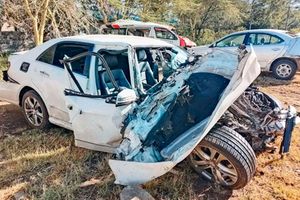Premium
How the arts help humanity endure the Covid-19 tragedy

A scene in the musical ‘Subira’ staged at the Kenya National Theatre in Nairobi on August 5, 2021.
It is hard to imagine that Covid-19 has its roots in the year 2019. When the disease broke out in 2019, not many people thought that it would cross international borders and cause serious social, cultural and economic disturbance.
Even medical experts initially thought Covid-19 was ‘mere’ flu that would pass with time. After all, millions of people all over the world catch flu annually and survive it. Politicians and government officials in many countries estimated that it won’t take more than five months for life to settle down to its normal pace. About two years on, the world doesn’t seem to know when this pandemic will go away.
Because human life is largely predictable, Covid-19 has caused tremendous social anxiety because of its unpredictability. One doesn’t know when the next ‘variant’ will be isolated and whether it might be more virulent than the previous one. Consequently, people are at the mercy of the unknown. Being vaccinated against one form doesn’t stop infection from a new form. Social distancing is easier preached than maintained.
Sanitising can be done but it is expensive and not necessarily wired into the human psyche. All these measures mean that social entertainment beyond the home has been severely affected. In some places there is no live music, no stage theatre, no sports, limited access to public spaces such as restaurants etc.
What has the arts and literature done to alleviate the human suffering in the past two years? It is obvious that without some form of entertainment – music, literature, theatre, film, dance, song, sports – much of humanity would have gone crazy by now.
How easy is it for people who are used to free movement, people who love to ‘unwind’ on the weekends, individuals who entertain themselves at life art and culture events, to endure being separated from such events, being distanced from their friends, loved ones and hobbies, being quarantined for days seemingly without end? It is no wonder that there have been efforts in some countries to stop governments from controlling the movement of people.
Cultural producers
Artists and cultural producers have probably suffered most. How does one create when she doesn’t mix with those who probably inspire her? Even though most artists claim to create in isolation, the encounter between two people leads to inspiration.
It sows the seeds of imagining the human condition and creating art that reflects on it but also archives that condition, at a particular moment, in a particular place, on, and sometimes, for a particular people. When Covid-19 arrived on these shores, it claimed the lives of artists and shut down much of the art spaces. But artists are not called creative for nothing.
Kenyan writers, actors, singers, painters etc may have been alienated from the spaces where they performed and the people for whom they created, but many found new ways of doing and sharing art. Artists went online.
DJs performed online. Spoken word artists met their audiences online. Musicians did concerts online. Writers shared their work on blogs and YouTube etc. The virtual space did save the day, in some sense, although it couldn’t really replace the experience of a live performance. So, when the quarantine regulations were relaxed, artists came back to the public spaces.
The Kenyan National Theatre, Alliance Francaise and the Goethe-Institut, to some extent, received back audience. Plays and art exhibitions and music performances have been happening in these venues, and many others, including the Ngong Racecourse, for some time now, since around August last year.
KNT has had several shows in both of its venues, including an International Theater Festival in the month of October. Artists have put on shows despite low attendances. But who can blame audiences?
The economy is in a bad shape. Attending public events is exposing oneself. It hasn’t been easy for the groups and individuals who have been producing plays at the KNT but the positivity and enthusiasm has shown the tenacity of the human spirit amidst the gloom of Covid-19.
One can only hope that the government will walk the talk and really put it some money in the arts and culture. Or should we make the call, once more, for the setting up of a National Council of the Arts and Culture, which could help in raising funds to support the sector, as well as support artists in skills development?
Genge music
The film and music sectors trudge on, though bedevilled by more problems than before. For the film industry (if at all it is one), life has been hard, especially now that donor funding has seriously dropped. Music, though, thrives – just Google and see how much rap/genge music is coming out of Nairobi Eastlands; taarab at the Coast; Luo benga/Luhya/Kikuyu/Kamba benga, among others. But Netflix happened and many producers/directors know that whereas cinema and dance halls are now history, and few Kenyans will buy local content, there is an avenue to disseminate their content to a global audience as well.
However, radio stations, TV and YouTube are the biggest promoters of Kenyan music and drama. Religious music groups, rappers, pop music groups etc are finding space and time on local radio stations and TV and having their content available internationally on YouTube. Online streaming isn’t just making the music and drama accessible to non-Kenyans, it is also earning them income that they wouldn’t have accessed before. Kenyan content producers may decry the lack of enough airplay on local radio and TV stations, but this is more of a marketing and circulation issue than of the quality of content.
On the literature front, the Kenya Publishers Association could not hold the annual Nairobi International Book Fair due to Covid-19. Again, book lovers were denied a chance to meet local and international publishers and authors in person as well as buy books at a discounted rates; attend seminars on writing and publishing; and hear invited authors speak about their works. One hopes that 2022 will bring good tidings, as KPA promises to hold a Nairobi Metropolitan Book Fair early in the year, should circumstances allow.
But the biggest news of the year on the book front was the Nobel Prize in Literature awarded to Abdulrazak Gurnah. Surprisingly not many East Africans had read or heard of him. Even in Tanzania some readers wondered how they hadn’t heard of a fellow mwananchi, now resident uzunguni but whose writings were being honoured. As it has happened in the past few years, many Kenyans had put their money on Ngugi wa Thiong’o.
Tough love
A few East Africans think that Nuruddin Farah is due to get the prize. But the gods of literature still smiled on East Africa. We remain hopeful that before the decade is over, they shall pass by our shores again. Ooh, and the other African Nobel laureate in literature released a gripping critique of the tragedy that is modern Nigeria. The dramatic novel Chronicles from the Land of the Happiest People on Earth reads more like tough love for his people and society.
It seems, though, that Kenyans decided that the one way to deal with the pandemic was to write. There have been tens of books on the market. Poetry, autobiographies, fiction etc. Here are a few titles to consider for the early days of the New Year.
The House of Rust by Khadija Abdalla Bajaber will take you on a see voyage in which you will encounter the fantastic; Kithaka wa Mberia released two plays, Walikiona cha Mtema Kuni and Kwenzi Gizani; Mukoma wa Ngugi’s Unbury Our Dead with Song is a homage to music in life but will remind Kenyans of our neighbours, Ethiopia, especially at this time when the country is caught up in a civil war; With Eyes Wide Open is Erick Gichuru’s family saga, detailing the tragedy of modern life; Grace Ndiritu recounts the allure of migration to Europe and its joys and disappointments in From Kenya to Europe: My Story; then there are the autobiographies of men who have been associated with power in Kenya Matu Wamae and MG Waweru, Born to Serve and Kenya’s Tax Czar respectively; and the memoirs of Oburu Odinga, In the Shadow of My Father; Charles Onyango-Obbo and Jospeh Odindo pay tribute to journalists and journalism in East Africa in the two books, Pioneers, Rebels, and a Few Villains and Hounded: African Journalists in Exile, respectively; Justice Nzioka wa Makau and Senior Counsel Pravin Bowry add to the body of writings on law in Kenya in their books, Labour Law & Industrial Relations in Kenya and A Guide to the Laws of Kenya, respectively.
This is a very thin and hardly representative sample but it shows the breadth of books that have been published by Kenyan authors. Magazines such as Awaaz, Jahazi, Down River Road, Jalada, The Savannah Memo, Nairobi Bookshelf etc continue to offer space for conversations on art and culture and related subjects from Kenya, the region and Africa.
Signs don’t portend well for 2022, what with the Omicron variant of Covid-19 sweeping through Europe and Asia! But one cannot second guess the human spirit to fight back and endure. And art best epitomizes that spirit. One can only pray that the artistic spirit will survive the onslaught of Covid-19 and live to tell the story to future generations of living in such unpredictable times.
The writer teaches literature and performing arts at the University of Nairobi. [email protected]





